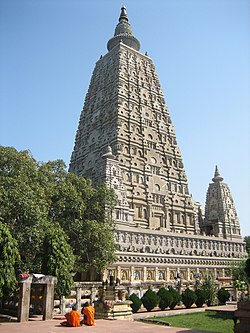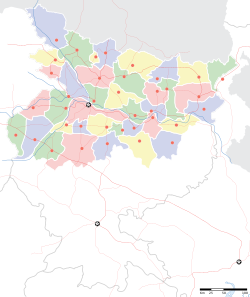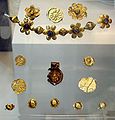http://en.wikipedia.org/wiki/Bodh_Gaya
Bodh Gaya
From Wikipedia, the free encyclopedia
| Bodh Gaya बोधगया Bōdh Gayā | |
|---|---|
| Town | |
 Mahabodhi Temple | |
| Coordinates: 24.695102°N 84.991275°ECoordinates: 24.695102°N 84.991275°E | |
| Country | India |
| State | Bihar |
| District | Gaya |
| Area | |
| • Total | 249 km2 (96 sq mi) |
| Population (2011) | |
| • Total | 38,434 |
| • Density | 150/km2 (400/sq mi) |
| Languages | |
| • Official | Magadhi, Hindi |
| Time zone | IST (UTC+5:30) |
Bodh Gaya is a religious site and place of pilgrimage associated with the Mahabodhi Temple Complex in Gaya district in the Indian state of Bihar. It is famous as it is the place where Gautama Buddha is said to have obtainedEnlightenment (Bodhimandala).
For Buddhists, Bodh Gaya is the most important of the main four pilgrimage sites related to the life of Gautama Buddha, the other three being Kushinagar, Lumbini, and Sarnath. In 2002, Mahabodhi Temple, located in Bodh Gaya, became a UNESCO World Heritage Site.[1]
Contents
[hide]History[edit]
| Pilgrimage to |
| Buddha's Holy Sites |
|---|
 |
| The Four Main Sites |
|
| Four Additional Sites |
| Other Sites |
| Later Sites |
Bodh Gaya is the most holy place on Earth for the followers of the Buddhist faith all over the world. Situated by the bank of river Neranjana the place was then known as Uruwela. King Ashoka was the first to build a temple here.[2]
Buddha was born 563 BC in Nepal [3][4] on the following auspicious Baisakhi purnima. As Siddhartha, he renounced his family at the age of 29 his gaining enlightenment in 534 BC [5][6] and travelled and meditated in search of truth. After meditating for six years at Urubela (Buddhagaya) in Gaya, he attained Buddhatva or enlightenment. Enlightenment is a state of having infinite knowledge, and being able to accomplish the Noble and Universal truths. By gaining enlightenment, you enter Nibbana, in which the final stage is Parinibbana. According to Buddhist traditions, circa 500 BC Prince Gautama Siddhartha, wandering as an ascetic, reached the sylvan banks of thePhalgu, near the city of Gaya. There he sat in meditation under a bodhi (fig) tree (Ficus religiosa). After three days and three nights of meditation, Siddhartha claimed to have attained enlightenment and insight, and the answers that he had sought. He then spent seven weeks at seven different spots in the vicinity meditating and considering his experience. After seven weeks, he travelled to Sarnath, where he began teaching Buddhism. It was here that he preached his first discourse in the deer park to set in motion the 'Wheel of the Dharma'. It is one of the most holy sites as in this place the stream of the Buddha's teaching first flowed.
At this place, the Buddha encountered the five men who had been his companions of earlier austerities. On meeting the enlightened Buddha, all they saw was an ordinary man; they mocked his well-nourished appearance. "Here comes the mendicant Gautama," they said, "who has turned away from asceticism. He is certainly not worth our respect." When they reminded him of his former vows, the Buddha replied, "Austerities only confuse the mind. In the exhaustion and mental stupor to which they lead, one can no longer understand the ordinary things of life, still less the truth that lies beyond the senses. I have given up extremes of either luxury or asceticism. I have discovered the Middle Way". This is the path which in neither easy (a rich prince) nor hard (living in austere conditions practicing self-denial). Hearing this, the five ascetics became the Buddha's first disciples.
These disciples of Gautama Siddhartha began to visit the place during the full moon in the month of Vaisakh (April–May), as per the Hindu calendar. Over time, the place became known as Bodh Gaya, the day of enlightenment asBuddha Purnima, and the tree as the Bodhi Tree.
The history of Bodh Gaya is documented by many inscriptions and pilgrimage accounts. Foremost among these are the accounts of the Chinese pilgrims Faxian in the 5th century and Xuanzang in the 7th century. The area was at the heart of a Buddhist civilization for centuries, until it was conquered by Turkic armies in the 13th century. The place-name, Bodh Gaya, did not come into use until the 18th century CE. Historically, it was known as Uruvela, Sambodhi, Vajrasana or Mahabodhi.[7] The main monastery of Bodh Gaya used to be called the Bodhimanda-vihāra (Pali). Now it is called the Mahabodhi Temple.
Five bombs were detonated in Mahabodhi temple premises on July 7, 2013. 4 bombs were also detonated in town while three were defused.
Mahabodhi Temple[edit]
Main article: Mahabodhi Temple
The complex, located about 110 kilometres from Patna, at 24°41′43″N 84°59′38″E,[8] contains the Mahabodhi Temple with the diamond throne (called the Vajrasana) and the holy Bodhi tree. This tree was originally a sapling of the Sri Maha Bodhi tree in Sri Lanka, itself grown from a sapling of the original Bodhi tree.
It is believed that 250 years after the Enlightenment of the Buddha, Emperor Asoka visited Bodh Gaya. He is considered to be the founder of the original Mahabodhi temple. It consisted of an elongated spire crowned by a miniature stupa and a chhatravali on a platform. A double flight of steps led up to the platform and the upper sanctum. The mouldings on the spire contained Buddhaimages in niches. Some historians believe that the temple was constructed or renovated in the 1st century during the Kushanperiod. With the decline of Buddhism in India, the temple was abandoned and forgotten, buried under layers of soil and sand.
The temple was later restored by Sir Alexander Cunningham in the late 19th century.[citation needed] In 1883, Cunningham along with J. D. Beglar and Dr Rajendralal Miitra painstakingly excavated the site. Extensive renovation work was carried out to restore Bodh Gaya to its former glory. It has a height of 55 metres which can be viewed from a distance of 11 km.by hrds
Other Buddhist temples[edit]
Kittisirimegha of Sri Lanka, a contemporary of Samudragupta, erected with the permission of Samudragupta, a Sanghārāma near the Mahābodhi-vihāra, chiefly for the use of the Singhalese monks who went to worship the Bodhi tree. The circumstances in connection with the Sanghārāma are given by Xuanzang (Beal, op. cit., 133ff) who gives a description of it as seen by himself. It was probably here that Buddhaghosa met the Elder Revata who persuaded him to come to Ceylon.
Several Buddhist temples and monasteries have been built by the people of Bhutan, China, Japan, Myanmar, Nepal, Sikkim, Sri Lanka, Taiwan, Thailand, Tibet andVietnam in a wide area around the Mahabodhi Temple. These buildings reflect the architectural style, exterior and interior decoration of their respective countries. The statue of Buddha in the Chinese temple is 200 years old and was brought from China. Japan's Nippon temple is shaped like a pagoda. The Myanmar (Burmese) temple is also pagoda shaped and is reminiscent of Bagan. The Thai temple has a typical sloping, curved roof covered with golden tiles. Inside, the temple holds a massive bronze statue of Buddha. Next to the Thai temple is 25 meter statue of Buddha [9] located within a garden which has existed there for over 100 years.
Mahabodhi Temple Serial Blasts[edit]
See also: 2013 Bodh Gaya blasts
On 7 July 2013 at around 5.15 a.m. a low intensity bomb blast took place in the 1500 year old Mahabodhi Temple complex. This was followed by a series of nine low intensity blasts and at least two monks are reported to be injured, one Tibetan and the other a Burmese. These blasts were carried out by an Islamic terrorist organisation, to seek revenge for the killings of Muslims in Burma. The serial blasts did not cause any damage to the temple or the tree under which Buddha attained enlightenment. Two other bombs, one under the 80-foot statue of the Buddha and the other near Karmapa Temple were defused by the police. The statue of the Buddha is now a symbol of the holy place Bodh Gaya, next to the Mahabodhi Temple, a World Heritage site.[10][11] Investigation of the blast was given to NIA (National Investigating Agency). Three unexploded bombs were also found in the Temple complex.
Demographics[edit]
As of 2001 India census,[12] Bodh Gaya had a population of 30,883. Males constitute 54% of the population and females 46%. Bodh Gaya has an average literacy rate of 51%, lower than the national average of 59.5%; with male literacy of 63% and female literacy of 38%. 8% of the population is under 6 years of age.
Transportation[edit]
- Bodhgaya is about 12 km from Gaya City.The NH83 Highway connects Gaya and Bodhgaya.
- The State Tourism Department provides travel facility from Patna to Bodh Gaya.
- Regular train and bus service for Gaya are available from Kolkata which is an overnight journey.
- Regular AC Buses have been introduced by BSTDC between Patna - Bodhgaya via Rajgir.[13]
- Besides, a special Caravan Service called Wonder on Wheel between Patna and Bodhgaya has been introduced by Bihar Tourism Deptt.[14]
Gaya International Airport[edit]
Bodh Gaya International Airport is situated 7 km from Bodh gaya and approximately 10 km from Gaya Railway Station.










No comments:
Post a Comment